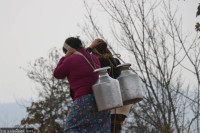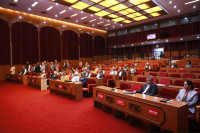Opinion
Strengthening Tamang women
Education and jobs will prevent them from falling into the trap of human traffickers
Samaya Lama
Seven out of every 10 girls who are victims of sex trafficking are from indigenous communities, according to the Shakti Samuha, an organisation which works against trafficking. Most of them come from Sindhupalchok, Kavre and Makwanpur districts surrounding the Kathmandu Valley. These districts have a high population of marginalised communities, especially Tamangs. Girls from the Tamang community, who were historically forced to serve as courtesans and concubines to the rulers in Kathmandu, make up most of the victims of sex trafficking to India and other countries.
Trafficked and exploited
In 2001, the International Labour Organisation (ILO) counted 4,227 children working in carpet factories in Kathmandu, most of them from the Tamang community. Besides being forced to work in hazardous conditions for little pay, they were subjected to sexual exploitation. In 2004, a survey conducted by Action Aid Nepal revealed that among the 270 cabin keepers working in 175 restaurants in the Valley, 10 percent were from Sindhupalchok, 9.5 percent from Dolakha and 9 percent from Kavre. Girls from the Tamang community made up 40 percent of them. As cabin keepers, these girls had to entertain clients, to the extent of providing sexual services.
A 2010 survey on Trafficking and Exploitation in the Entertainment Sector and Sex Industries in Nepal, which was conducted by Swiss child aid organisation Terre des hommes, covered 63 female workers in the entertainment sector, and half of them were Tamangs. Many studies have concluded that trafficking is most common in the Tamang, Gurung and Magar communities. Historical evidence proves that the Tamang community was subjected to attempted genocide because they were very aggressive towards the Gorkha rulers. Govinda Neupane wrote in his 2000 article entitled Nepalko Jatiya Prashna (Ethnic Question of Nepal), “The Tamangs revolted twice against King Rana Bahadur Shah and King Girvan Bikram Shah in 1873, but they could not succeed.” In retaliation, Tamangs were not allowed to join the Gurkha army or serve in the East India Company which deprived them of social and economic growth.
Trafficking has mostly been attributed to illiteracy, unemployment, poverty, political turmoil, natural disasters and various social factors. Based on my personal experience as a member of the Tamang community, I would say that Tamang people are easy to convince because they tend to believe anyone instantly without any doubts in their mind. Most Tamangs live in rural areas and are illiterate. They have little access to the outside world. Today, connectivity has increased, but many things remain to be improved. Due to their illiteracy and poverty, they are gullible easily fall into the trap of traffickers. Both men and women fall prey to traffickers, but women are more vulnerable. This applies to women of all social settings as they are the most exploited and deprived class.
Taken advantage of
Secondly, homemade alcohol is part of the culture and day-to-day life in the Tamang community. All Tamang men and woman routinely drink liquor. Among other communities in Nepal, particularly among the Khas Arya community, drinking alcohol is not accepted, especially by women. Drinking liquor removes inhibitions and makes us more open to interaction. Openness is good, but it has generally been proven to be not so good for disadvantaged women.
Tamang women, who are among the disadvantaged groups in Nepal and lack education and financial resources, are easily persuaded by traffickers with talk about the glittering beauty of life in the city. In today’s globalised world, everyone wants to go to the city to live a luxurious life as their friends are already living there.
This situation pulls impoverished people from the villages to the city, and they ultimately fall into the trap of traffickers.
In 2006, Nepal settled the Maoist conflict with the Comprehensive Peace Accord which was a result of People’s Movement II. This marked Nepal’s official transformation into an inclusive democracy. The new constitution supports and accepts the identity of each marginalised group. The government is trying its best to tackle the problem of trafficking; but government efforts alone are not enough. Being an indigenous community, we have occasional communal gatherings. Such gatherings can play a big role in mitigating trafficking.
Steps to be taken
Communal gatherings can address trafficking issues locally by forming anti-trafficking women groups (AWG). The AWGs will empower and train Tamang girls about the issue of trafficking. The AWGs will be powerful as they will be led by local women under the surveillance of the Tamang community.
Secondly, local Tamang communities should prepare short- and long-term strategies to identify issues and priority sectors. Likewise, our communal gathering organises many cultural programmes and provides assistance during the Chewar (bratabandha) ceremony, Ghewa (funeral procession) and marriages. This is not enough
for the development of the Tamang community. We need to diversify our working pattern by making the education of Tamang boys and girls as our first priority.
When boys and girls are educated, they are likely to get good jobs and live a better life. Their income will ultimately be spent on education and other necessities of the people. Educated women with good jobs are less likely to fall into the trap of traffickers than women without education and jobs. Moreover, employed women spend freely on the development of their kids. This will ultimately end the vicious cycle of women trafficking as women will have better options and opportunities in their life.
Lama is a director of Garjan-Nepal, a non-profit organisation




 11.12°C Kathmandu
11.12°C Kathmandu











